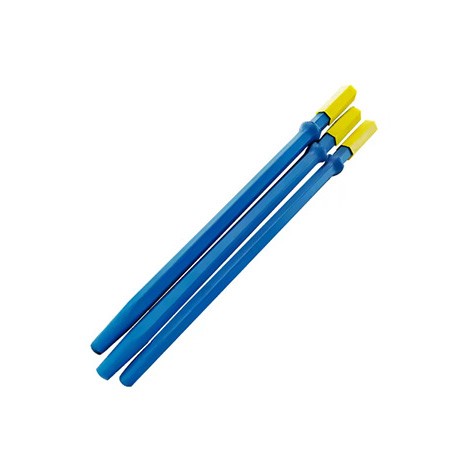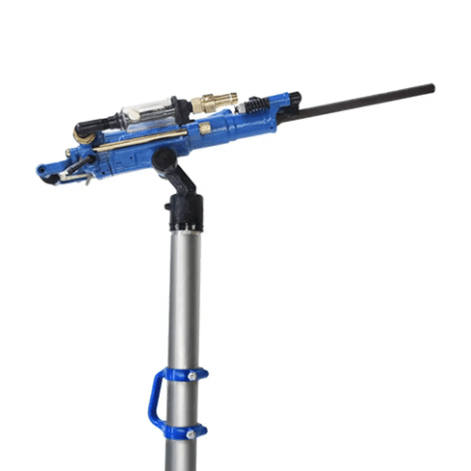Are you looking to make your drilling operations more efficient and reach greater depths? Understanding extension rods and drill rods is key for anyone in mining, tunneling, or construction. This guide will walk you through everything you need to know about these essential drilling tools, making even complex concepts easy to grasp. Keep reading to discover how the right drill rod can significantly impact your project's success.
1. What is a Drill Rod and Why is it So Important in Rock Drill Operations?
A drill rod is a fundamental component in rock drill operations. Think of it as the backbone of your drilling setup. This sturdy rod is a long, often cylindrical piece of drill steel that transfers the impact energy from the rock drill to the drill bit. Without a drill rod, the power of the top hammer wouldn't reach the rock face, making drilling impossible. The drill rod endures significant stress and pressure during drilling operations, so its quality and durability are paramount. A reliable drill rod ensures efficient energy transfer, reduces wear and tear on your drilling rig, and ultimately saves you time and money. Different lengths of rods are available to suit various drilling requirements.
The importance of a drill rod goes beyond simply transferring power. It also plays a crucial role in flushing cuttings away from the hole. Many drill rods are designed with a central hole that allows air or water to be pumped through, clearing the debris and keeping the drill bit cool. This efficient removal of cuttings prevents the bit from getting stuck and improves drilling speed. Choosing the right drill rod with appropriate thread type and material is critical for optimizing your drilling performance. The drill rod connects directly to the shank of the rock drill and to the coupling sleeve that joins it to other rods in the drill string.
2. Extension Rods Explained: How Do They Extend Your Drilling Reach?
Imagine needing to drill a deep hole. A single drill rod might not be long enough. That's where extension rods come in. An extension rod is a specialized type of drill rod designed to increase the drilling depth. These rods are generally connected in a series, one after another, using couplings, to create a longer drill string. Extension drill rods play a vital role in applications requiring deep holes, such as underground mining, tunneling, and large construction projects. The use of extension rods allows operators to reach significantly deeper than would be possible with a single drill rod.
The primary function of an extension rod is precisely as its name suggests: extension of drilling depth. By adding different lengths of rods, you can customize the length of the drill string to match the specific drilling requirements of your project. This modularity is a significant advantage, allowing for flexibility and adaptability in various drilling environments. Extension rods are manufactured with the same high standards as regular drill rods to ensure they can withstand the demanding conditions of rock drilling. They also feature threads on both ends for easy connection to other rods and couplings.
3. What Materials are Drill Rods Typically Made Of? Exploring Drill Steel Options.
The strength and longevity of a drill rod depend heavily on the material it's made from. Drill steel is the common term for the high-quality alloy steel used in manufacturing these crucial drilling components. This specialized steel is chosen for its exceptional strength, toughness, and resistance to wear and fatigue. Different grades of drill steel exist, each formulated to provide optimal performance in specific drilling applications. Factors like the hardness of the rock being drilled and the type of rock drill being used influence the selection of the appropriate drill steel.
Common alloying elements in drill steel include carbon, manganese, silicon, and chromium. These elements contribute to the steel's ability to withstand the intense impact forces and abrasive conditions encountered during rock drilling. The manufacturing process of drill steel involves careful heat treatment to achieve the desired hardness and toughness. Some drill rods may also undergo surface treatments to further enhance their wear resistance and service life. Understanding the properties of drill steel is crucial for selecting rods that will perform reliably and minimize downtime in your drilling operations. We're offering high quality drill rods made from premium drill steel.

4. Thread Talk: Understanding the Different Thread Types Like T38, T45, and R32.
The thread on a drill rod is not just a simple spiral. It's a precisely engineered feature that ensures a secure and efficient connection between rods, couplings, and the rock drill. Different thread designs exist, each with specific advantages for various drilling conditions and equipment. Common thread types you'll encounter include T38, T45, and R32, among others. The "T" and "R" designations typically refer to the thread profile, while the numbers indicate a dimensional characteristic, often related to the diameter or pitch of the thread.
T38 and T45 threads are commonly used in top hammer drilling, offering a robust connection suitable for demanding applications. R32 threads are another popular choice, known for their good balance of strength and ease of use. The choice of thread type depends on factors such as the size of the drill, the torque requirements, and the overall drilling system design. Properly matched threads are essential for preventing premature wear, ensuring efficient energy transfer, and maintaining the integrity of the drill string. You'll often find rods are available from 600mm and up with these different thread types. We can help you find professional advice on selecting the right thread for your needs.
5. How Do Drill Rods and Extension Rods Connect? The Role of Couplings.
To create a continuous drill string using drill rods and extension rods, a vital component is needed: the coupling sleeve, often simply called a coupling. A coupling is a short, cylindrical piece with internal threads that match the external threads on the rods. It essentially screws onto the ends of two rods, securely joining them together. The coupling must be strong enough to withstand the rotational forces and impact energy transferred through the drill string during drilling operations.
The design of the coupling is critical for maintaining alignment and ensuring efficient energy transfer. High-quality couplings are manufactured with tight tolerances to minimize play and vibration in the drill string. Different types of couplings are available, including standard couplings and crossover couplings used to connect rods with different thread types. Properly tightened couplings are essential for preventing rod separation and ensuring the safety and efficiency of your drilling operations. Think of the coupling as the bridge connecting each section of your drill string.
6. What are the Different Parts of a Drill Rod System? Examining Shanks and Adapters.
Beyond the drill rods and couplings, other important components make up a complete drill rod system. The shank adapter, often just called a shank, is a crucial part that connects the drill rod to the rock drill. The shank is designed to withstand the percussive forces of the top hammer and transmit them efficiently to the drill rod. Different rock drills have different shank designs, so selecting the correct shank adapter is crucial for compatibility.
Another key component is the adapter. While "shank adapter" is a specific term, other adapters might be used within the drilling system to connect components with different thread types or sizes. For example, a coupling might act as an adapter if it joins rods with different thread specifications. Understanding the function of each component, from the shank to the coupling, is essential for maintaining and troubleshooting your drilling equipment. We provide a range of drilling components, including high-quality shank adapter options.
7. Top Hammer Drilling: How Do Extension Rods Fit into This Powerful Technique?
Top hammer drilling is a powerful and widely used method for drilling holes in rock. In this technique, a percussive rock drill, mounted on a drilling rig, delivers repeated impacts to the back of the drill string. Extension rods are integral to top hammer drilling when drilling deeper holes. The drill string, composed of multiple extension rods connected by couplings, transmits the impact energy from the top hammer down to the drill bit at the bottom of the hole.
The efficiency of top hammer drilling relies on the proper selection and maintenance of the drill rod string. The rods must be strong enough to withstand the intense percussive forces and the rotational torque applied by the drilling rig. Extension rods allow top hammer systems to achieve significantly greater drilling depth compared to direct drilling methods. This makes top hammer drilling with extension rods a preferred technique in mining, tunneling, and quarry operations. Top hammer drilling tools are designed for high performance and durability.
8. Extension Rods in Action: Where are They Used in Mining and Tunnel Projects?
The use of extension rods is widespread in various demanding industries. In mining, extension drill rods are essential for drilling blast holes for controlled explosions, allowing for the extraction of valuable resources. Both surface and underground mining operations rely heavily on extension rods to reach the required drilling depth. Similarly, in tunnel construction, extension rods are crucial for drilling blast holes to excavate through rock and create passageways.
Beyond blasting, extension rods are also used in mining tunneling for drilling anchor holes to install ground support systems, ensuring the safety and stability of underground workings. Large-scale construction projects, such as dam construction and road building through mountainous terrain, also utilize extension rods for various drilling applications. The ability to achieve significant extension of drilling depth makes extension rods indispensable in these industries. You'll find our rods are often used in challenging drilling environments.

9. Finding the Right Drill Rod Supplier: What to Look For?
Selecting a reliable rod suppliers is crucial for ensuring the success of your drilling projects. When looking for a supplier, consider factors such as the quality of the drill steel used, the precision of the thread manufacturing, and the overall durability of the rods. A reputable supplier will offer rods that meet industry standards and can withstand the harsh conditions of rock drilling. Look for a rod manufacturers and suppliers with a proven track record and positive customer feedback.
Consider the range of drilling tools offered by the supplier. A comprehensive supplier will provide not only drill rods and extension rods but also complementary components like couplings, shank adapters, and drill bits. Competitive price is important, but prioritize quality and reliability to avoid costly downtime and equipment failures. Litian Heavy Industry Machinery Co., LTD is a professional manufacturer focused on providing high-quality drilling tools. You can extend drilling capabilities with the right supplier.
10. Related Litian Articles: Dive Deeper into Drilling Technologies.
To further enhance your understanding of drilling tools and techniques, explore our other informative articles. Learn more about the different types of drill bits available and how to select the best one for your specific rock formation. Discover the advantages of using various shank adapter designs for optimal energy transfer. Delve into the intricacies of top hammer performance and how to maximize its efficiency.
Our resources provide valuable insights into the world of rock drilling, helping you make informed decisions about your equipment and operations. From understanding thread types to optimizing your drilling rig setup, our articles are designed to empower you with the knowledge you need for success. Explore our related litian articles to become a more informed and effective drilling professional.
Key Takeaways:
- Drill rods are essential for transferring impact energy from the rock drill to the drill bit.
- Extension rods increase drilling depth by connecting in series.
- Drill steel is a high-quality alloy steel chosen for its strength and durability.
- Different thread types like T38, T45, and R32 offer specific advantages.
- Couplings securely join drill rods and extension rods.
- Shank adapters connect the drill rod to the rock drill.
- Extension rods are crucial for achieving deep holes in top hammer drilling.
- Mining and tunnel projects heavily rely on extension rods.
- Choose a drill rod supplier based on quality, reliability, and product range.
- Explore additional resources to deepen your knowledge of drilling tools.
For high-quality extension drill steel and a wide range of rock drilling tools, contact us at Self drilling anchor tools factory. Explore our selection of Rock Drilling Bits and related products like Shank adapters.
Post time: 1 月-03-2025














